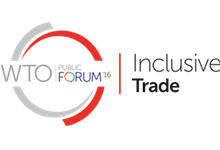The new landscape of inclusion in digital trade
28 Sep 2016 15:30h - 17:00h
Event report
[Read more session reports and live updates from the 2016 WTO Public Forum.]
This session, organised by the International Centre for Trade and Sustainable Development (ICTSD), examined the concept of inclusion from multiple angles, and explored the ways in which trade can facilitate greater inclusion.
Andrew Crosby, Managing Director of the ICTSD, opened the debate by looking at the importance and dimensions of inclusion. Digital trade has the potential to include great parts of the population, and relates to a large number of sustainable development goals (SDGs). Yet, the ultimate success of digital solutions depends on the enabling environment in which it is placed. Furthermore, the diversity of interpretations of what ‘inclusion’ means can lead to different ways of implementing solutions.
The next speaker was Kati Suominen, Founder and CEO of the Nextrade Group and Founder and Chairwoman of TradeUp Capital Fund. She highlighted the enormous economic potential of e-trade, as well as some of the challenges related to limitations to market access, customs requirements, unreliable online payments, etc. Quoting a case from Latin America and the Caribbean, she showed that the removal of such limitations could lead to an ‘extremely significant’ revenue growth of about 65%. Ways to remove these barriers in the context of the WTO could include an agreement on interoperability of online payments, or the promotion of digital regulatory harmonisation among countries.
Martina Francesca Ferracane, Policy Analyst at ECIPE, highlighted the example of fab labs as an initiative that can boost inclusion and trade. Fab labs are workshops that aim at making ‘almost anything’. This allows individuals to create their own products. In a typical fab lab, you can find 3D printers, laser cutters and milling machines. Fab labs can boost inclusive trade in a number of ways. They promote 21st century education by incentivising people to learn and attain modern skills, connect students with companies, and provide courses to all interested individuals, empowering them to make their own creations. Furthermore, they lower the barriers to engage in business, through their open source policy and the possibility for fast prototyping. Ultimately, fab labs are part of what Ferracane called Industry 4.1 – the increased engagement of consumers in the manufacturing process.
Ferracane also mentioned some of the policy challenges related to fab labs, including:
- Intellectual property rights
- Ownership of data
- Tariffs and taxation
- Legal liability and safety standards
- Testing and certification
She ended her presentation by providing some reflections on the socio-economic implications of Industry 4.1.
Marcela Palva Véliz, Councillor of the Permanent Mission of Chile, provided a perspective from the field of intellectual property. She gave an overview of the developments in Internet adoption and innovation, leading to the question whether we are optimally using digital tools for creation and innovation. Moreover, she emphasised the need for clear rules, and the continued relevance of the protection of intellectual property, while noting that the intellectual property system needs to be sufficiently balanced and flexible. Finally, she promoted increased awareness about the need for intellectual property, and the creation of an environment in which it can stimulate innovation and creation.
Finally, Don McDougall, Councillor of the Permanent Mission of Canada, explained the situation of digital technology, inclusion, and trade in his country. He outlined the ways in which digital tools can contribute to inclusive growth, especially by connecting rural areas, providing high-quality jobs to the middle class, and boosting small and medium enterprises. He also mentioned the challenges of digitalisation, which can lead to the creation of ‘winners and losers’, and division rather than inclusion. To mitigate these consequences, the government, often in collaboration with the private sector, is investing in infrastructure and skills development.
McDougall echoed Crosby’s emphasis on the need for an enabling environment. In practice, this may be established through a wide range of measures, such as transparent regulation, consumer trust, net neutrality, electronic payment systems, and recognised e-signatures.
In the context of the WTO, there are existing tools that could facilitate e-commerce (ITA, TFA, Telecoms Annex), yet there is a knowledge gap between members with and without experience in digital trade that remains to be bridged. Finally, for the WTO to remain relevant, McDougall argued that the digital economy must be an integral part of the institution’s agenda, as ‘we need to have an ongoing, robust dialogue on how trade intersects with the digital economy’.
by Barbara Rosen Jacobson
Related topics
Related event

